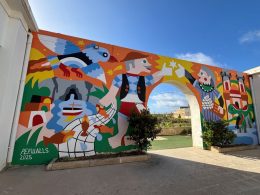Anton Inglott’s (1915–1945) Sacred Heart of Jesus was presented to the Malta Society of Arts on behalf of students who attended classes at the Society in 1943.
Inglott was part of a generation of artists who, having broadened their artistic horizons by studying and travelling abroad, introduced modern art to Malta. Since the Church was the primary source of commissions for artists, it was common for religious subjects to be interpreted through the artistic styles and techniques of the time. The deepest notions of the radical modernist project, however, were kept in check by the conservative power of Church and state authorities, resulting in artworks that had to balance their innovation with tradition.
Censorship and dismissal were recurring responses to artworks perceived to be too avant-garde. One example is the removal of Giorgio Preca’s (1909–1984) Crucifixion (c. 1948) from Stella Maris Church. At other times, works were rejected for being perceived as too socialist – such as when Victor Pasmore’s (1908–1998) offer to donate a painting from his 1970 exhibition The Space Within to the MSA was declined.
Similar to these cases, Inglott’s Sacred Heart of Jesus was one step too far down the road of change and immediately created controversy. His portrayal of Jesus as a stylised and dark-skinned figure was not accepted, and the replacement of the heart with an abstract flood of light ran counter to Catholic iconographic tradition. One jeering remark was that Christ seemed to be holding a 100-watt bulb in his hands.
The consecration ceremony was postponed indefinitely, and the painting was relegated to a storage space in the Society’s basement. Ultimately, the Sacred Heart of Jesus was rejected in favour of a commission from Inglott’s close friend, Emvin Cremona (1919–1987), who painted a more literal, and therefore more conventional, version of the Sacred Heart. This painting now forms part of the MSA’s collection and is currently on display in the Chapel.
Eventually, Inglott’s Sacred Heart of Jesus was rediscovered by a new generation of researchers and curators, and it came to be recognised as a masterwork of Maltese modern art. It was retrieved from the MSA basement, spent time in the archive at Palazzo de La Salle, and is now on display at the heart of the Society’s collection.
In 2024, Inglott’s heirs, now bearing the surname Vella Gera, auctioned off a large part of their family holdings. Roderick Camilleri, the MSA’s current Vice President, identified a sketch during the auction viewing and advised the Society to acquire it, believing it to be an unsigned and undated original study for the Sacred Heart of Jesus painting.

“During one of my routine explorations at a local auction viewing – a habit that often unveils hidden gems from private collections – amidst the array of modern artworks, one unassuming sketch grabbed my attention. There it was, an unassuming sketch, yet my mind instantly made the connection… It was probably the bozzetto, the preparatory study, for the Society’s very own ‘Sacred Heart’. This wasn’t just another piece; I immediately realised that this was a missing link, a vital step in the creation of a work we hold dear. Recognising its profound significance, I immediately alerted the Society, urging them to acquire this crucial piece of Inglott’s artistic journey, ” explains Camilleri.
This sketch offers insight into Inglott’s process. For example, in the sketch, the heart of Jesus is visible as a small, flesh-coloured blur, suggesting that Inglott’s transformation of the heart into a cataract of light – his boldest and most radical gesture – was a later decision.
Amongst other things, the symbol of the Sacred Heart is an analogy for divine love made physical. There is something sensitive about how Inglott draws the heart – the organ most prone to breaking – within a protective shell of light, expressing a desire to shield this most human aspect of Christ. Throughout his short life, Inglott also suffered from debilitating diabetic conditions, so we know that maladies of the flesh were something he was well acquainted with.
It is impossible not to connect Inglott’s thinking to the forces that, by the mid-20th century and barely 20 years after World War I, had torn up the world once again. Having cut his studies short and returned from Rome due to the imminent outbreak of war, Inglott felt the threat of fascism acutely, and from his drawings and letters we also know that he lived through the blitz of Valletta.
“A generation that had gone to school on horse-drawn streetcar,” writes the philosopher Walter Benjamin in 1936, “now stood under the open sky in a countryside in which nothing remained unchanged but the clouds, and beneath those clouds, in a field of force of destructive torrents and explosions, was the tiny, fragile, human body.”
Inglott was part of this generation for whom nothing in their world remained untouched by death – not even their spirituality.
He created spiritual art under the looming threat of World War II, fascism, and ill health. His transformation of the heart into light can be read as an act of defiant hope that, when drawn into the present moment, prompts questions about contemporary global struggles—from conflict to pandemics – and rekindles discussions about the role of spirituality and art in the face of human strife.
The exhibition, produced by the Malta Society of Arts, runs from May 5 -21
More on Anton Inglott
Anton Inglott (1915–1945) was a prominent Maltese artist known for his expressive, spiritual works and poignant depictions of wartime Malta. Born in Ħamrun on New Year’s Day, he showed early talent in drawing and studied at the Government School of Art under the Caruana Dingli brothers. In 1938, he furthered his education at the Regia Accademia di Belle Arti in Rome, where he was deeply influenced by the Italian Renaissance. Returning to Malta in 1940 due to World War II, Inglott created powerful wartime drawings and religious works despite his declining health from diabetes. Inglott died on August 15, 1945, aged 30, leaving behind a wife, a young daughter, and a legacy celebrated in numerous exhibitions and retrospectives over the decades.
This article was provided by Malta Society of Arts










